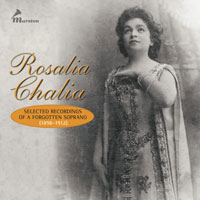Track Listing
| CD 1: (76:48) | ||
| 1. | SEMIRAMIDE: Bel raggio (Rossini) | 2:17 |
| July 1900; Seven-inch Zonophone T9139 | ||
| 2. | IL BARBIERE DI SIVIGLIA: Io sono docile (Rossini) | 2:37 |
| November 1900; Seven-inch Zonophone Q9204 | ||
| 3. | IL BARBIERE DI SIVIGLIA: Dunque io son (Rossini) | 2:34 |
| with Alberto de Bassini, baritone
Ca. 1898; Bettini cylinder |
||
| 4. | STABAT MATER: Quis est homo (Rossini) | 2:04 |
| with Jane Frankel, contralto
4 December 1900; Seven-inch Victor 554 Take 2 |
||
| 5. | DON GIOVANNI: La ci darem la mano (Mozart) | 2:58 |
| with Emilio de Gogorza, baritone
24 May 1901; Ten-inch Victor 3401 |
||
| 6. | L’ÉTOILE DU NORD: Barcarolle (Meyerbeer) | 2:09 |
| July 1900; Seven-inch Zonophone 9136 Take 3 | ||
| 7. | FAUST: Ah! je ris de me voir [Jewel song] (Gounod) | 2:26 |
| 3 June 1901; Ten-inch Victor 3431 | ||
| 8. | CARMEN: Si tu m’aimes (Bizet) | 2:49 |
| with Emilio de Gogorza, baritone
24 May 1901; Ten-inch Victor 3406 |
||
| 9. | CARMEN: Je dis que rien ne m’épouvante (Bizet) | 2:15 |
| July 1900; Seven-inch Zonophone Q9134 | ||
| 10. | LA TRAVIATA: Ah, fors’ è lui (Verdi) | 2:32 |
| November 1900; Seven-inch Zonophone Q9208 Take 2 | ||
| 11. | LA TRAVIATA: Addio del passato (Verdi) | 2:16 |
| November 1900; Seven-inch Zonophone Q9207 Take 2 | ||
| 12. | UN BALLO IN MASCHERA: Ma dall’arido stelo divulso (Verdi) | 2:14 |
| November 1900; Seven-inch Zonophone Q9199 Take 2 | ||
| 13. | AIDA: O patria mia (Verdi) | 2:01 |
| November 1900; Seven-inch Zonophone Q9203 Take 2 | ||
| 14. | BOHEMIAN GIRL: I dreamt that I dwelt in marble halls (Balfe) | 3:00 |
| 3 June 1901; Ten-inch Victor 3434 | ||
| 15. | ‘Tis the last rose of summer (Old Irish Air; words by Moore) | 2:18 |
| November 1900; Seven-inch Zonophone 9200 Take 5 | ||
| 16. | Il Bacio (Arditi) | 2:28 |
| November 1900; Seven-inch Zonophone 9206 Take 2 | ||
| 17. | La Calasera (Yradier) | 2:21 |
| July 1900; Seven-inch Zonophone T9137 Take 4 | ||
| 18. | Tú [Habanera] (Sánchez de Fuentes; words by Sánchez) | 2:12 |
| November 1900; Seven-inch Zonophone T9448 | ||
| 19. | Zortzico vizcaíno (Spanish Folk Song) | 2:13 |
| July, 1900; Seven-inch Zonophone T9135 Take 2 | ||
| 20. | Polo (Spanish Folk Song) | 2:30 |
| November 1900; Seven-inch Zonophone T9457 | ||
| 21. | Fandango (Spanish Folk Song) | 2:23 |
| November 1900; Seven-inch Zonophone T9453 | ||
| 22. | La Borinqueña (Attributed to Ramirez; Puerto Rican National Anthem) | 2:32 |
| 24 May 1901; Ten-inch Victor 3407 | ||
| 23. | Aires criollos (Camora) | 2:41 |
| 3 June 1901; Ten-inch Victor 3428 Take 2 | ||
| 24. | La Partida (Álvarez) | 2:43 |
| 3 June 1901; Ten-inch Victor 3432 | ||
| 25. | Los Ojos Negros (Álvarez) | 3:20 |
| 18 April 1912; (B-11892-1) Ten-inch Victor 63681-A | ||
| 26. | Una Noite (Curros Enríques; Canción Gallega) | 4:28 |
| 9 February 1912; (C-11578) 12-inch Victor 68400-A | ||
| 27. | Lungi dal caro bene (Secchi) | 3:14 |
| 9 February 1912; (B-11581) Ten-inch Victor 63674-A | ||
| 28. | Pietà, signore [Preghiera] (Attributed to Niedermeyer) | 3:30 |
| 5 March 1912; (B-11669) Ten-inch Victor 63674-B | ||
| 29. | CAVALLERIA RUSTICANA: Voi lo sapete, o mamma (Mascagni) | 3:29 |
| 18 April 1912; (C-11895-1) 12-inch Victor 68400-B | ||
Accompaniments: Tracks [1-24] accompanied by piano; Tracks [25-29] accompanied by orchestra | ||
Producer: Ward Marston
Audio Conservation: Ward Marston
Audio Assistance: J. Richard Harris
Photographs: Girvice Archer, Gregor Benko, and Roger Gross
Booklet Design: Takeshi Takahashi
Marston would like to thank Gregor Benko, John R. Bolig, Ramona Fassio, Lawrence F. Holdridge, Nicole Rodriguez, Michael Sansoni, and Richard Warren for their help in the production of this CD release.
The following selections are re-recorded from copies in the collection of Mr. and Mrs. Laurence C. Witten II in the Yale Collection of Historical Sound Recordings, Yale University Library:
Tracks: [2, 3, 5, 8, 15, 22, 27-28]
Chalia photos are extremely scarce. Despite efforts to find more photos, Marston has utilized all that could be located.

Rosalia Chalia:
Selected Recordings of a Forgotten Soprano (1898-1912)
Rosalia Chalia was born into Cuban nobility in 1866 and despite her family’s wishes, she mounted a tremendously successful stage career. She was especially known for her Santuzza, which she sang at the Metropolitan Opera in the 1898 – 1899 Season. But possibly her greatest mark will be her role as the first major operatic star to make a series of disc recordings: the Eldridge R. Johnson Improved Record (Victor) in 1900 – 1901. She also sang for Bettini, Zonophone, and Columbia. Her records are rare and hard to find in good condition. Her voice is extremely flexible with a huge range and supple timbre. She negotiates coloratura passages with breathtaking agility and beauty. Her recordings are spellbinding and each one is a treasure.